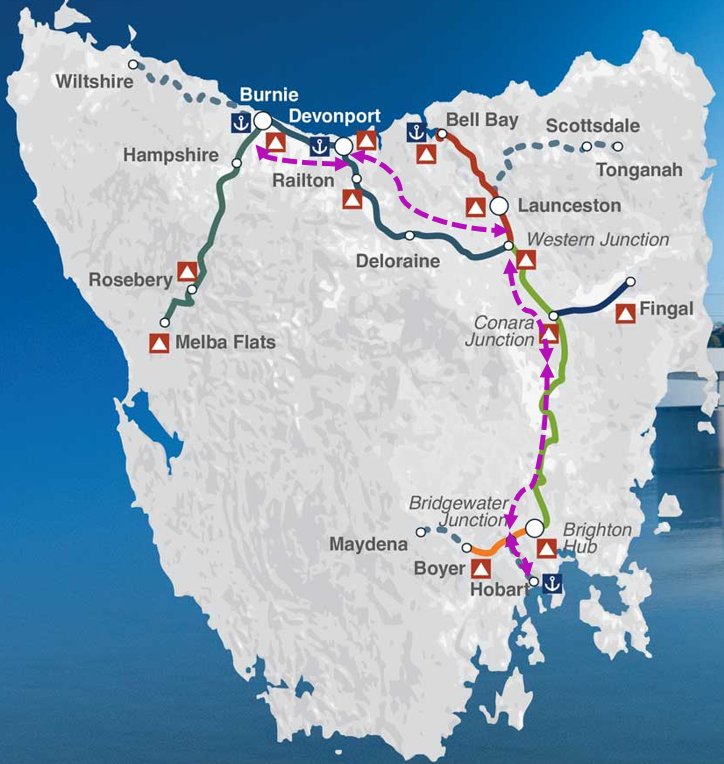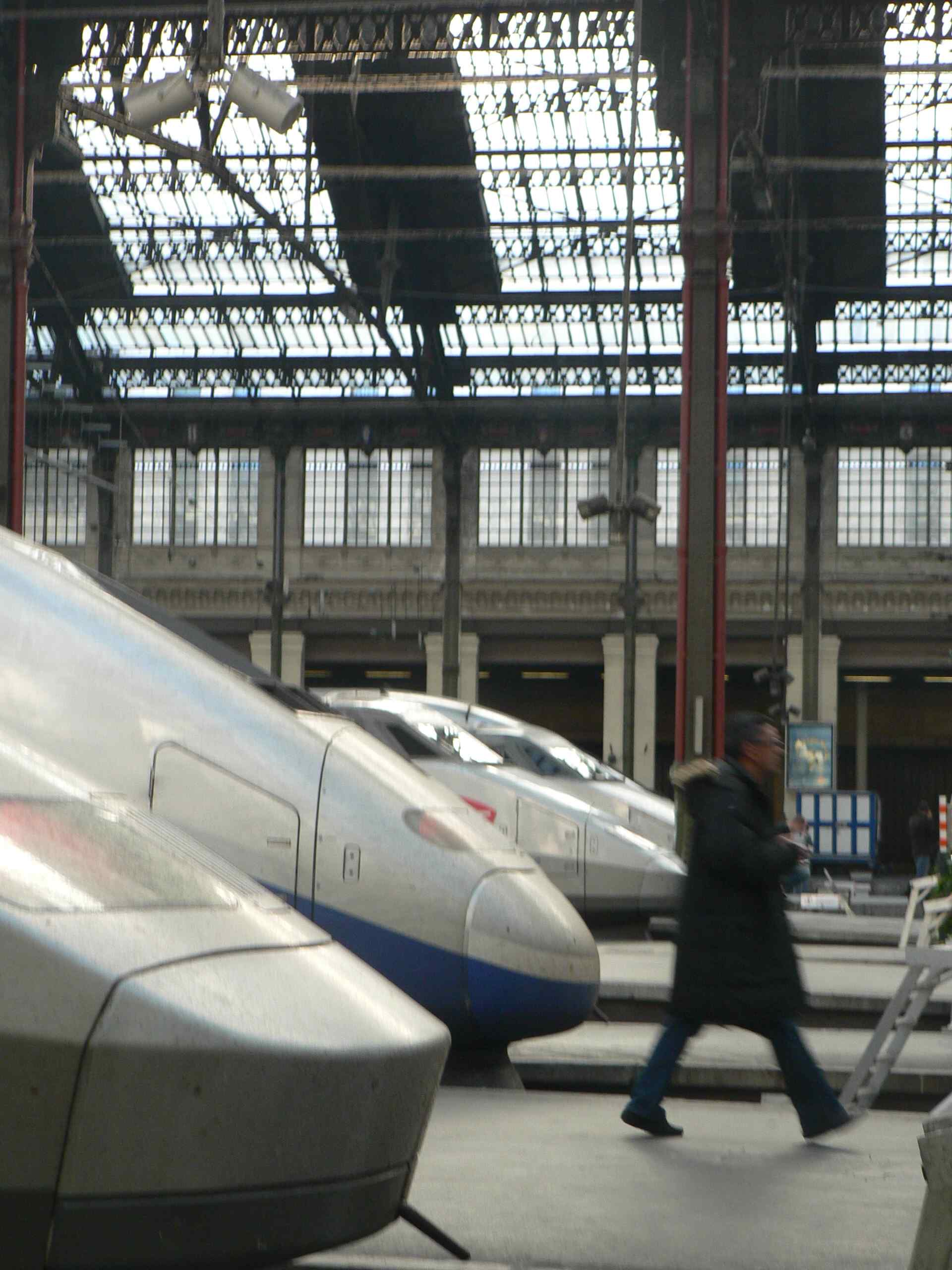Why is a food blog interested in a VFT (Very Fast Train) route from Burnie through to Hobart via Devonport and Launceston?
Well, wouldn’t it be wonderful to be able to board a train in Launceston at 6.30 pm, for dinner at a Hobart restaurant at 7.30 pm, then be home by bedtime!
In the following map, the dream VFT route – Burnie <> Devonport <> Launceston <> Hobart – is indicated by the arrows and dotted lines along the existing rail system.
Viable or Fantasy?
It has to be a fantasy, of course: how could such a costly technological marvel possibly happen in Australia’s smallest state? For the optimistic among us, though, such a dream is realisable!
A VFT is about much more than food and wine: it is all about connecting the Tasmanian community. Thus, could it be possible for someone to live in Burnie and be at work in Hobart within an hour’s travel, or to catch a plane from Launceston airport in half an hour? Could it be possible for someone in Hobart to get to an AFL game in Launceston with just 30 minutes on a train? Could whole families from the north-west and north go to a day-night big-bash cricket match at Bellerive and be home well before midnight, or see a concert by the Tasmanian Symphony Orchestra at Federation Hall in the afternoon and be home for dinner?
Many countries have VFT systems. France and Japan pioneered them. China is now building an extensive network. Typically VFTs run on electricity, with a travelling speed of 300km/hour or more. More and more countries are on the move! The following photo, and the others in this blog post, was taken at Gare de Lyon in Paris, one of the main departure points for the French system.
There are two video links given later in this blog post about VFT systems. One is about the Shanghai Maglev Train, one of the fastest trains in the world. At full speed, the journey of 30 km takes 7 minutes and 20 seconds to complete. A train can reach 350 km/hour in 2 minutes, with the maximum normal operation speed of 431 km/hour reached thereafter. (Wikipedia)
Tasmania is gradually reinventing itself, but there would be nothing bolder than the technological statement of one of the fastest train systems on earth.
The VFT would truly unite the State for work, sport and recreation. The VFT would be an iconic draw for tourists: for the thrill of the ride or to see it streaking past them in the countryside.
Why a VFT is not appropriate for the east coast of Australia
For many years there has been talk about a VFT along the Australian east coast (from Melbourne through to Brisbane, via Canberra and Sydney). One estimate is that the cost would be $114 billion for the 1748 km journey (see link below).
Problems with the east coast route are:
1. Australia is made for planes, not trains. The country is ideal for flying because of the relative sparseness of settlements and the huge distances between these relatively few cities and locations. Out of any nation, Australia should be the most able to perfect this form of transport. There are concerns about the environmental impacts from air travel, however, improvement in this area will continue, as demonstrated by improvements in other areas of transport and the sustainable energy sector.
2. Because of the long distances between the four main cities, flying will always be much faster than a VFT system which is more suited to relatively short trips. Thus a VFT is unlikely to be able to compete against air travel: commercial jet aircraft cruise between 700 and 900 km/hour. In existing large cities with limited space, new VFT stations won’t necessarily be built in the centre and may not be much easier or faster to access than the existing airports on the city extremities.
3. The east coast VFT would be a massive concentration of infrastructure building that benefits a select, already prosperous, and relatively small part of the country.
4. This extraordinary amount of money can be better spent to tackle other transport and social problems at far less cost and with far greater benefits. For example, train level-crossings in the cities, which hold up road traffic, can be replaced; tunnels can be built under cities for better car and rail travel; rail lines can be built to city airports; airports and services at regional centres could be significantly upgraded. There would be way less pollution from fuel and there would be lots of money left over.
5. The east coast VFT is contrary to decentralisation. Instead it centralises activity along the route, with nothing happening elsewhere in the country. Can Australia have a future where the countryside and indeed all corners of the country are not adequately populated?
Why a VFT is appropriate for Tasmania
While Tasmania is the least populous state and the sixth least populous state or territory, it could be argued that it is the most densely populated of the states. Visitors to Tasmania will be surprised, while driving around, as to how often they come across towns, hamlets and settlements every few kilometres. Victoria has the highest density of the states and territories, excluding the ACT. However, remove the capitals (Melbourne, Sydney, Hobart, etc.) and Tasmania’s density approaches Victoria’s. Further, much of Tasmania consists of protected areas: 42%. This is a far greater proportion than any other state. Adjust for density based on populations outside the capital cities living in non-protected areas and Tasmania’s density is the greatest. (See end of blog post.)
In fact, the vast majority of Tasmania’s population is located in the region along the corridor of the proposed VFT route of Hobart-Launceston-Devonport-Burnie, as per the map above.
There are many arguments for a VFT on this route:
1. The distances are perfect for VFT travel.
Driving times:
– Hobart to Launceston: 200km, 2 hours 30 mins
– Launceston to Devonport: 100 km, 1 hour 10 mins
– Devonport to Burnie: 50 km, 35 mins
– Burnie to Hobart: 330 km, 3 hours 45 mins
2. Flying within Tasmania is no longer feasible or possible. Commercial flights between the four cities no longer seem to exist, and making a journey by air – for example, Hobart to Launceston – is likely to have to be done via Melbourne over several or many hours. Without flights, driving or bus are the only options.
3. A VFT would cut the travel time between destinations dramatically. Smaller centres along these routes – Ulverstone, Deloraine, Oatlands – could access the VFT relatively easily by car or it may be possible to have some VFT stops in between the four main centres. Thus, there could be express trains (only stopping at the four main centres) and more frequently stopping services (in between the four).
4. A VFT assists in decentralising the population, with people able to travel easily and quickly for work or recreation purposes. High house prices in Hobart can be avoided by living in another centre. Much of the Tasmanian community would become genuinely connected. It seems that at the moment Hobart is prospering while other centres lag behind. The Bass Strait and Tamar Valley regions are among the most scenic in the country and have a wonderful summer climate. With better transport it is possible their populations could boom. Instead of being backwaters they could become communities with sophisticated industries, facilities and lifestyles.
5. The cost of building the system and who funds it is the big question. However, there are already existing rail corridors (see link below) that may be useable, helping to defray costs by minimising land acquisition. It might only cost a fraction per kilometre compared to the east coast route discussed above. The Greens should support the proposal (see links below).
6. As Tasmania specialises more and more in fine products (not just food and wine) the VFT may provide rapid freight transport to the Devonport ferry service.
7. The technological aspects of building and then running the VFT would make an amazing difference to the technology industry in the state. There would be an increase in investment and company locations, and employment opportunities both within, and flowing from, the VFT system.
8. Barriers and divisions within the State will be broken down. It seems to play cricket for Tasmania a cricketer must move to Hobart to live; with a VFT they would not have to. Tasmania might finally get a team in the AFL, once it is realised that close to the whole population of the state can easily get to a game, wherever it is held.
9. It should be a tourist magnet: to be able to travel on the VFT or see it in operation.
10. MONA, wine and gourmet producers, and improving access to national parks are examples of the state reinventing itself. However, the VFT will be the most emphatic statement of all. Given climate change, Tasmania may become a sought out place to live: it needs to be ready. It can be a follower or it can be a leader.
Links and extra information
Australia: Some history about high speed train travel in Australia
Tasmanian rail system: Map
TGV routes France (this link might not viewable on tablet or smart phone; use computer to view): France
This link is about the top ten fastest trains in the world: Top ten fastest
The Shanghai Maglev Train: The video itself is somewhat long but the first half indicates the possibilities, type of track, travel time, etc. It is built above ground on concrete pillars. See Shanghai 1 and Shanghai 2.
Is a VFT for Australia viable? See: The Conversation or see: The Age
A VFT in Tasmania should be supported by environmental groups: The Greens
Research by The Greens shows significant benefits for regional Australia, which must mean significant benefits for regional Tasmania. Regional benefits
Jeff Kennett: Effusive about Tasmania. This link might require access to the website. Kennett talks about creativity in Tasmania: Barnbougle and Lost Farm golf courses; MONA, … He wrote: “All [these people] have made decisions that helped create a new, vibrant Tasmania. How I love inspiration and aspiration. Visionaries are worth their weight in gold.” Jeff Kennett
AFL and Tasmania: Again access to the website might be restricted, but there are many articles on this topic. An AFL team in Tasmania
Hobart in the investment limelight: Hobart
Population density:
Tasmania is ranked fourth in terms of population density. Australian States
Persons per square kilometre:
1 ACT 171.40
2 Victoria 26.11
3 New South Wales 9.52
4 Tasmania 7.55
5 Queensland 2.76
6 South Australia 1.73
7 Western Australia 1.02
8 Northern Territory 0.18
Persons per square kilometre in non-protected areas outside capital cities. Protected areas by State
1 Tasmania 7.36
2 Victoria 6.45
3 New South Wales 3.53
4 Queensland 1.46
5 South Australia 0.47
6 Western Australia 0.24
7 Northern Territory 0.08
ACT Not Applicable




